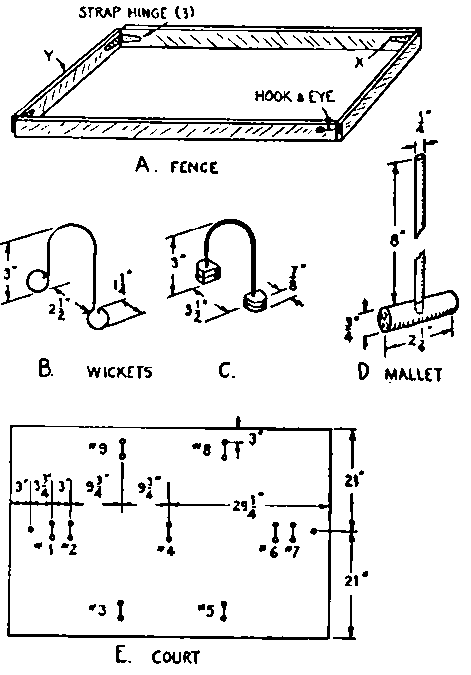Table Croquet
Description
This section is from the book "How To Build Games And Toys", by B. W. Pelton. Also available from Amazon: How To Build Games And Toys.
Table Croquet
In this country, lawn croquet has all but disappeared from the scene, along with the spacious grounds which formerly accommodated the game. Indoor versions, played on fairly large tables with balls or marbles have not proven successful, unless some sort of fence is provided to keep the balls from rolling off the table.
An easy way to slow down the rolling game to ping-pong or dining table size is to replace the balls and mallets with wooden disks or checkers, snapped by the fingers. This style of play usually requires a local ground rule which will permit unfortunate players who are stymied at impossible angles between the double wickets to remove one wicket, or use a dowel cue. Or dowel cues may be used throughout the game to create an interesting combination of billiards, shuffleboard, and croquet. An initial decision must be made as to whether the disks are to be pushed or struck by the cue at each stroke.
The ball and mallet game, however, is not only much faster, but more accurately duplicates the skill required in the outdoor game. If marbles are used as balls, it is no great chore to hinge a folding fence from furring strips which, when set on edge as in A, Figure 5.11, will confine this game to the top of an average sized dining table.
The remainder of the equipment is of equally simple construction. The best wickets are 121/2-in. lengths of heavy coat hanger wire, bent into the shape shown in B. Baling wire will hold its shape longer, but is more difficult to bend. An easier although less substantial type to make can be bent from 61/2-in. lengths of wire embedded in tight fitting holes drilled in a pair of checkers for each leg, with a 1/8-in. section sliced off the inside edges, as in Figures 5.11 C.
The end posts or stakes are 21/2-in. lengths of 1-in. dowel rods, but off squarely so that they will stand firmly erect. Make nine arches and at least one spare.
As indicated in D, the mallet heads are 21/4-in. lengths of f-in. doweling, with f-in. handles 81/2 in. long. Make six mallets and at least one spare. A different colored stripe can be painted around each mallet head; the posts may be candy striped with the colors used on the mallets. The balls are 1-in. marbles of contrasting colors.
Rules
For those who have forgotten or have never played croquet, the following resume applies either to free-lance play or partners. Partners are usually decided by playing at the beginning stake from the center of the court. First and third nearest the stake team up against second and fourth. This also decides the order of play.

Fig. 5.11. Table croquet equipment.
1. The direction of play is through the first two wickets, then over through No. 3 on the right, then No. 4 in the center, again to the right through No. 5, and then through No. 6 and No. 7 and hit the turning stake, returning counterclockwise via No. 8, No. 4, No. 9, and back through No. 1 and No. 2, and hit the starting stake.
2. The ball must be struck, not pushed, under penalty of loss of turn, and for each wicket through which a player passes in the proper direction, he is allowed an additional stroke.
3. When a player strikes another ball with his own, he is entitled to two additional shots. He also has a choice as to how to take these two strokes. He may place his ball against the one hit and drive the two in any desired direction, and thereafter take an additional shot. Or he may place his ball against the one he hit, and with his finger (foot) firmly on his own ball, drive the other ball in any desired direction and then take another shot; if his own ball moves at the first shot, however, his play is ended. Or he may place his ball a mallet head away from the ball he hit and take two strokes. Until he passes through a wicket, or hits the turning stake in proper order, he is "dead on" the ball he hit and cannot gain any strokes by hitting it again. A player is allowed to drive his own partner through the wicket at which he is aiming.
4. A player who has completed the turn and has passed through all the wickets in proper order, may become a "rover" by refusing to hit the home stake which eliminates him from the game. A "rover" plays in regular turn and no ball is dead to him at the beginning of any play. He may drive his opponents out of position, drive his partner into position or through a wicket, or place himself so that his partner can play off him. If a rover is driven by an opponent to strike the home stake, he is eliminated from the game. Thereafter the opponents take two shots to the remaining partner's one.
Continue to:


